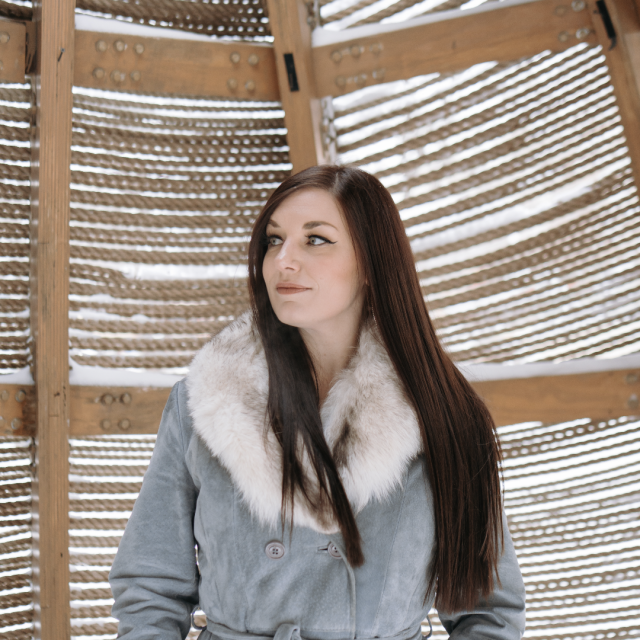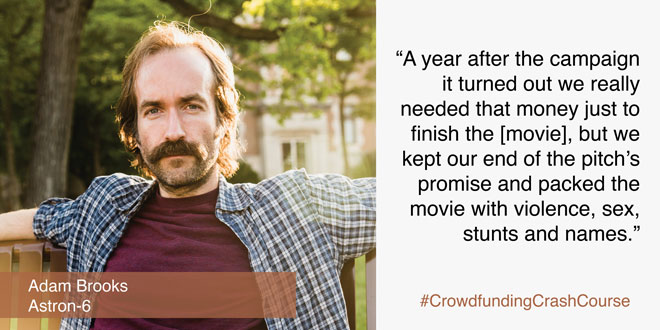Tagged: crowdfunding
Crowdfunding Crash Course: Mike Raven - The Travelling Book
- by Alyson Shane
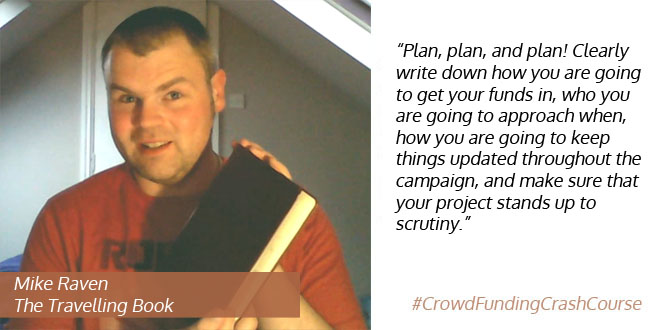
Mike Raven is a blogger and video maker from Hull, UK. He used Indiegogo to generate interest and fund his project The Travelling Book.
Can you briefly describe the Travelling Book Project?
The Travelling Book project is a project to help the world connect.
Essentially, the project was to send out a number of “travelling books” (blank journals) that would travel the world from person to person, with each person writing in the journals information about themselves and their lives. When each journal is full it’s supposed to come back to me for me to scan and put on the Internet, so anyone can see where the journal traveled and who it met. This way you could discover what different parts of the world was like actually from the people living there.
I’m still waiting for one of them to make it home!
Why did you feel that the crowdfunding model was the best way to promote the product
When I first had the idea, I decided that I would send five books out. However, when I asked friends and family if they wanted to get involved, straightaway I discovered that there was more demand than there was books available. And I thought to myself that if they wanted to take part, they might be willing to pay.
The great thing about crowdfunding in this case was that the project could scale e.g. people would pay for as many books as they want, and I could put the extra money generated towards a project website which I wouldn’t have been able to create otherwise.
Why and how did you choose Indiegogo over other crowdfunding options available?
To be quite honest, I tried Kickstarter first, and I couldn’t work out how to set it up to work in my country (the UK)! Also, Geek & Sundry had at the time just used Indiegogo to fund the third season of TableTop so it seemed a sensible choice. Indiegogo was the first crowdfunding website and is the second biggest crowdfunding site after Kickstarter so it is well-established.
All that said, Indiegogo does actually have one massive advantage over Kickstarter, and that’s Flexible Funding - the fact that I would receive the funding (minus Indiegogo fees) even if I didn’t reach my target goal was a fantastic benefit for my project, where I didn’t need to reach the target I set.
How big was your budget before you launched your crowdfunding campaign?
Pretty much nothing! I was willing to buy a few blank journals and mail them out to people out of my own pocket, but bearing in mind that each one sent out costs up to £8 - and I don’t really have much spare cash - I was more or less starting with nothing.
How far along was your project before you felt ready to launch a crowdfunding campaign? In hindsight, would you have preferred to be farther along, or to have crowdfunded earlier?
I jumped into crowdfunding far too early on. I basically had the idea for the project, did a quick Facebook post about the project, from that thought that there might be value in doing a crowdfunding campaign, and set it up with a small amount of planning. It was a fine stage of the project to do the crowdfunding, but I should have planned more.
Can you explain how you prepared for and managed your campaign?
I read a lot of blogs about crowdfunding and how to do it. I learned that I needed to get a good amount of income early on in the campaign so I lined up friends and family to donate right at the start so I could show progress, and that worked well.
I had roughly planned how I was going to promote the project and where to, but to be honest I could have done a lot more.
What tools did you use to market your campaign? Do you feel like you did so successfully, and if not, what could you have done differently?
I used various social media channels - my blog, my YouTube channel, Twitter (I use Hootsuite to set up tweets in advance) and Google+ groups, I also did a lot of work promoting the project manually by emailing literally hundreds of writing groups around the world, going on my local radio station, and I also found my old colleges and universities liked to hear about an alumni of theirs doing something that they put could on their blogs (it worked quite well that I ran the campaign in the summer when they probably didn’t have anything better to promote!)
In retrospect what were your best assets for running this successful campaign? On the other hand, what would you do differently?
Friends and family were a great help to me and kept me motivated throughout. However, I should definitely have planned more. For example, as I say I emailed tons and tons of writing groups. However, they generally only meet once every 4-8 weeks, and as my campaign was only a month, sometimes I’d miss their meetings.
Another thing was a lot of my promotional literature was very amateurish - my graphic designs skills are non-existent, and basic things like having a half decent logo, some good pictures and branding were missing.
What was your biggest challenge during your campaign?
I would say keeping motivated, but it did seem like every time I started to get a little downhearted another donation would come in and cheer me up! Finding the right crowd was difficult - I went for writing groups but I’m not entirely sure that I quite got the right people, I do think to this day that if I had marketed the project better I could have got a huge amount of interest.
What’s the most valuable advice you could share with aspiring crowdfunders?
Plan, plan, and plan! Get clearly written down how you are going to get your funds in, who you are going to approach when, how you are going to keep things updated throughout the campaign, and make sure that your project stands up to scrutiny - what exactly are you going to do with the money, when are people going to get the thing you’re promising, and how are you going to deliver?
This post is part of the #CrowdfundingCrashCourse series. You can find the entire series of interviews and summary posts here.
Crowdfunding Crash Course: 4 Lessons Learned So Far
- by Alyson Shane
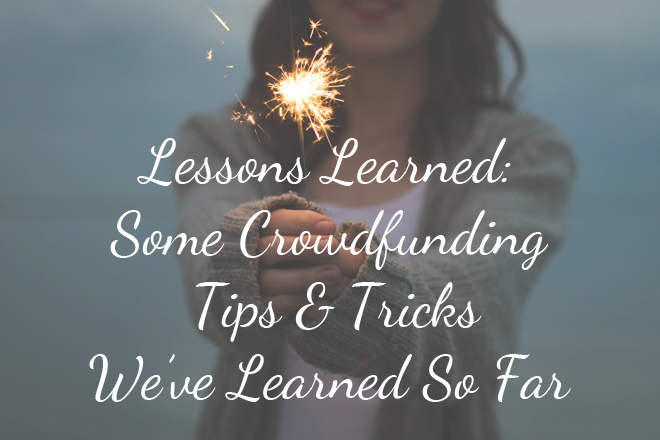
Last week's interview with Khan Vikshyn marked the 5th installment of the Crowdfunding Crash Course series, and with that in mind I thought it would be helpful to start posting some summary-style posts which outline and feature some of the recurring themes and insight we've heard so far:
Promote Ahead of Time
Everyone interviewed mentioned using social media as part of their promotional arsenal, but few people mentioned using it prior to the campaign to drum up interest and build excitement around the campaign.
Meghan Athavale of Po-Mo Inc mentioned in her interview that one of the reasons why their initial Kickstarter campaign didn't reach its goals was because they didn't promote it properly ahead of time, and instead relied on the campaign itself as their promotional tool. In her interview she explained that she had learned from this experience and had spent a significant amount of time promoting her next Kickstarter in a variety of ways (paid Facebook ads, regular posts, Tweets, social shares, interviews, etc) to generate interest before the campaign launched.
The Takeaway: Use every tool at your disposal to promote your campaign before it starts. This can include Facebook posts, Tweets, LinkedIn messages, and frequent mentions in your newsletter, if you have one. Plus good old-fashioned word-of-mouth!
Have a Plan
One of the things that stood out for me throughout all the interviews was the level of preparedness required to run a successful crowdfunding campaign. Devin Reimer of OWLchemy Labs referred to the campaign as "one of the hardest and most stressful things I have ever done" and Khan Vikshyn mentioned that in order to prepare himself for his campaign he spent six months researching, reading, watching videos, etc. to gain a better understanding of what he was setting himself up to do.
The Takeaway: Do as much research as possible and prepare a detailed plan. Hire someone to help you if necessary (and you can afford it). A great example is how Khan Vikshyn's 45-day plan helped him stay organized and kept his project from overwhelming him.
I managed my campaign by creating a 45 day plan so I’d stay on track and would know what I should be doing each day and how far along I expected to be. I knew that once I kicked things off I’d be too busy doing things to research and plan so I had to be as prepared as possible.
- Khan Vikshyn
Factor in Hidden Costs
One of the things that stood out for me in Adam Brooks of Astron-6's interview was when he mentioned that he wished that he had budgeted for all the postage that he spent on the rewards, and Kelly Tindall also mentioned researching things like shipping outside of Canada, weight of shipped items, etc.
Adam mentioned needing "a cool project and cool rewards" in order to get people motivated to participate, which is definitely something to remember - people want to feel like they're getting something interesting or unique for their contribution in addition to the finished product, itself. However, not being prepared to deliver these rewards could negatively impact your campaign and cost you a lot more than you realize, if you aren't budgeting and planning for it.
The Takeaway: Think long and hard about the types of backer rewards you're planning to offer, and factor in things like shipping costs ahead of time. If possible, try to avoid having to ship things to anyone (eg: offer a digital download over a DVD) and save yourself the worry of having to budget to ship multiple types of items at different times during your campaign.
Reach Out to Everyone You Can
One recurring theme throughout everyone's interviews was that they made a point to reach out to everyone that they knew for support, both in terms of campaign contributions and also for spreading the word.
In addition to reaching out to friends, family, and their existing audience via social media, they reached out to local news outlets, relevant organizations who could promote their campaign, and a variety of online communities who would be receptive to sharing and supporting the campaign.
I have very loyal family and friends who really stepped up to help out with money and were willing to talk to others about the campaign... I had over a year’s worth of loyal fans who couldn’t wait to read a print version of [Strangebeard], too.
- Kelly Tindall
The Takeaway: Your campaign's success depends on your ability to get as many people as possible to contribute, so don't be afraid to ask friends and family for support, and make as many relevant news outlets and online communities aware of your campaign ahead of time. That way you can build on the momentum to keep interest (and donations!) going until you've hit your goal, or beyond!
Keep a very open mind, spend as much time as possible building an email list, and don’t be afraid to ask for help. You are about to ask hundreds of strangers for their money.This post is part of the #CrowdfundingCrashCourse series. You can find the entire series of interviews and summary posts here.
- Meghan Athavale
Crowdfunding Crash Course: Steve Meier aka Khan Vikshyn - Normal People
- by Alyson Shane
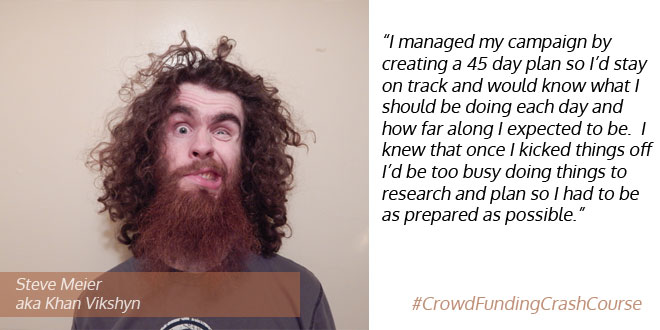
Steve Meier, aka Khan Vikshyn, is a Winnipeg-based poet and hip hop musician. He used Indiegogo to fund his debut album, Normal People.
Can you briefly talk about your album?
My album is called Normal People. I describe it as being inspired by everyday situations I face as a young man trying to find my way in life while working a dead end job and moonlighting as a rapper hoping to someday “make it” in the music industry. It’s available at khanvikshyn.bandcamp.com and in Winnipeg at Into the Music, Music Trader and HMV in Portage Place.
Why did you feel that the crowdfunding model was the best way to promote your album?
I felt that crowdfunding was the best way for me to promote my album because it allowed me to build excitement and a buzz around my project that I wouldn’t have been able to build otherwise. The people who donated to my campaign are still engaged and excited to see what I do next with my album.
Why and how did you choose Indiegogo over other crowdfunding options available?
I chose Indiegogo because it looked like one of the most legitimate and widely known platforms I could find and it didn’t seem to have many barriers in the way of getting started. It seemed more geared towards what I was planning to do and had a lot of projects by independent artists with smaller budgets and networks. It also offered the flexible funding option, meaning I would get whatever funds I raised regardless if I reached my fundraising goal or not.
How big was your budget before you launched your crowdfunding campaign?
I didn’t really have much of a budget before launching my campaign. Crowdfunding forced me to really look at what I was doing and set a budget and a direction. If I didn’t raise money this way I would probably still be in the position I was before I launched my campaign – an artist with a dream but no clear path – and it’d be years before I’d get a project out.
How far along was your project before you felt ready to launch a crowdfunding campaign? In hindsight, would you have preferred to be farther along, or to have crowdfunded earlier?
I had two songs recorded and mixed before launching my campaign. I think I was at the right point in creating my album when I decided to launch my campaign and ask for people’s help with the rest of it.
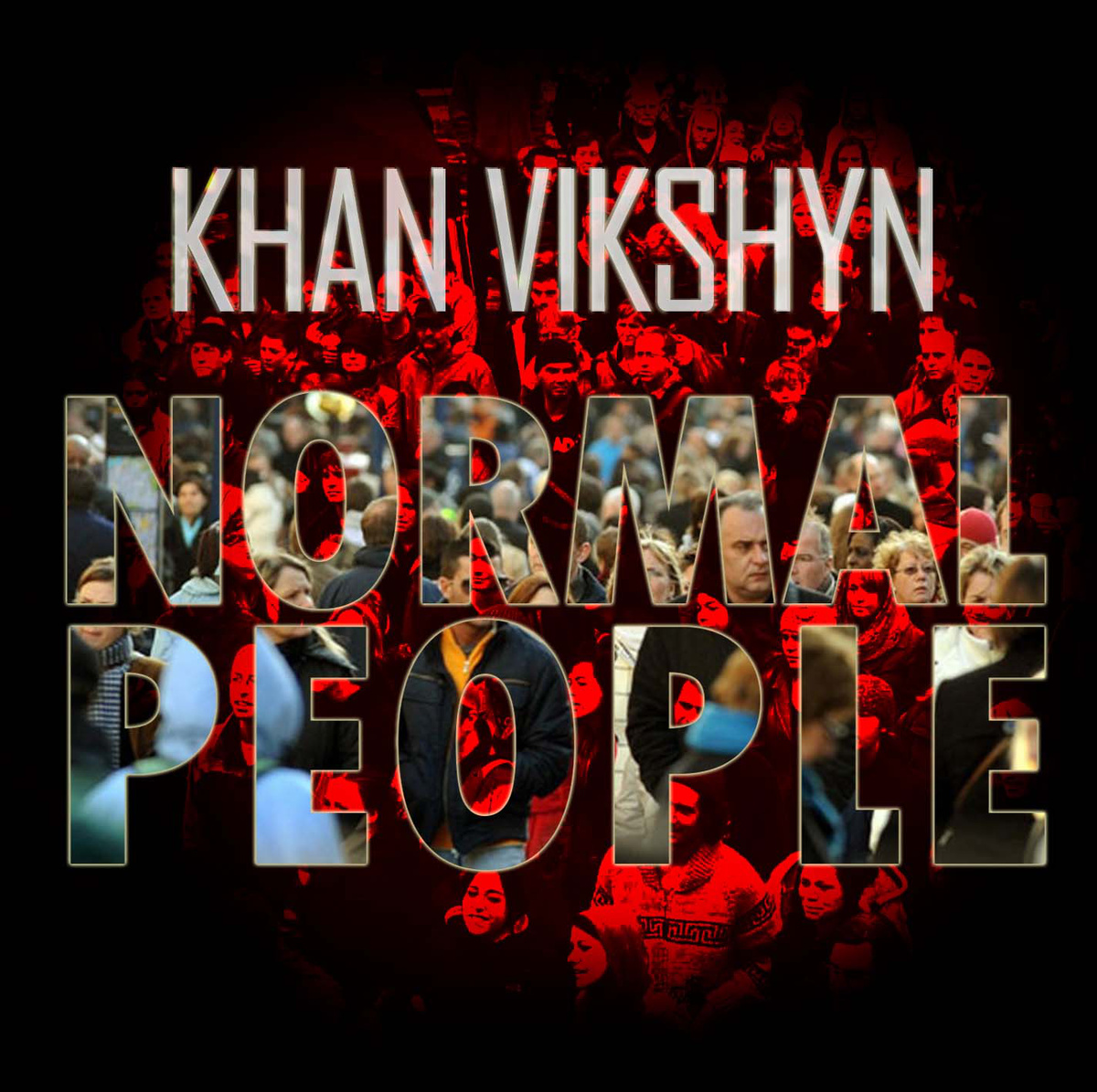
Can you explain how you prepared for and managed your campaign?
I prepared for my campaign by spending about 6 months absorbing as much information as I could on successful crowdfunding campaigns by reading articles and watching videos on other people’s experiences. I managed my campaign by creating a 45 day plan so I’d stay on track and would know what I should be doing each day and how far along I expected to be. I knew that once I kicked things off I’d be too busy doing things to research and plan so I had to be as prepared as possible.
What tools did you use to market your campaign? Do you feel like you did so successfully, and if not, what could you have done differently?
I marketed my campaign online and offline. I contacted people by phone and email and through Facebook and Twitter to ask if they’d consider donating towards my campaign. I also posted up flyers around Winnipeg and held a series of busking concerts with friends/artists of mine that I filmed and uploaded to YouTube and shared on Facebook.
In retrospect what were your best assets for running this successful campaign? On the other hand, what would you do differently?
I think my best assets for running my successful campaign were being open and transparent about what I planned to do with the funds I raised so people felt more comfortable about giving me money toward my project. If I could do something differently I would have spent more time researching ways to get picked up by media and blogs because I didn’t have much media coverage. I sent a press release to the [Winnipeg] Metro, CBC Radio and Winnipeg Alternative Media, and WAM posted it on their Facebook page.
What was your biggest challenge during your campaign?
The biggest challenge I faced during my campaign was overcoming negativity I sensed from those who didn’t understand what I was doing and didn’t take it seriously. Some people thought it was charity or that I was being lazy but I came to realise that not everyone is going to “get it” but you just need to do it anyway. It allowed me to really focus on the people showing me support and positivity because they’re the fans and the ones that matter.
What’s the most valuable advice you could share with aspiring crowdfunders?
The most valuable advice that I could share with aspiring crowdfunders is to not get discouraged and give up. Also, be prepared. Put in the necessary time to research how to run a successful campaign and have a plan in place for what you’re going to do before you kick things off. Once you launch you should be confident that you know what you’re going to do to accomplish your goal.
This post is part of the #CrowdfundingCrashCourse series. You can find the entire series of interviews and summary posts here.
Crowdfunding Crash Course: Devin Reimer of OWLchemy Labs - Dyscourse
- by Alyson Shane
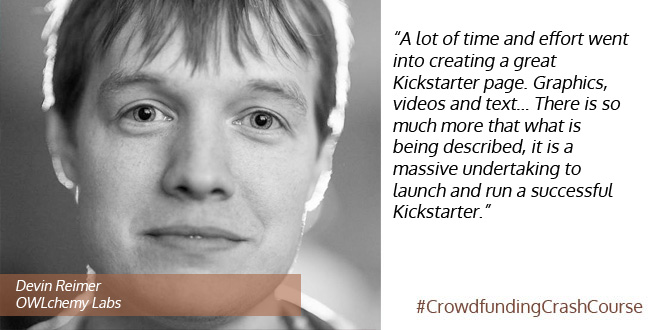
Devin Reimer is the CTO (Chief Technology Owl) at OWLchemy Labs, who are a group of "scientists on a search to find the formula behind the perfect enjoyable, silly gaming experience." Devin and the OWLchemy crew used Kickstarter to fund their game Dyscourse.
Can you briefly describe Dyscourse?
Dyscourse is an interactive choose-your-own adventure where you journey through a stylized world of choice and consequence. You play as Rita, an unfortunate art school grad turned barista, who is now stuck on a desert island with a crew of oddball travelers after a plane crash. That last choice you just made? It may end up being integral to your group’s survival, or it may lead you down a path to murder and cannibalism!
Why did you feel that the crowdfunding model was the best way to promote the game?
We hadn't yet done crowdfunding so it was something we wanted to try. We were about 7 months into development of Dyscourse, which would be the biggest title we had ever built. So crowdfunding allow us to let people see what we were working on much sooner so we could get feedback. Also this would start the word of mouth about what Dyscourse is and hopefully get people excited about it.
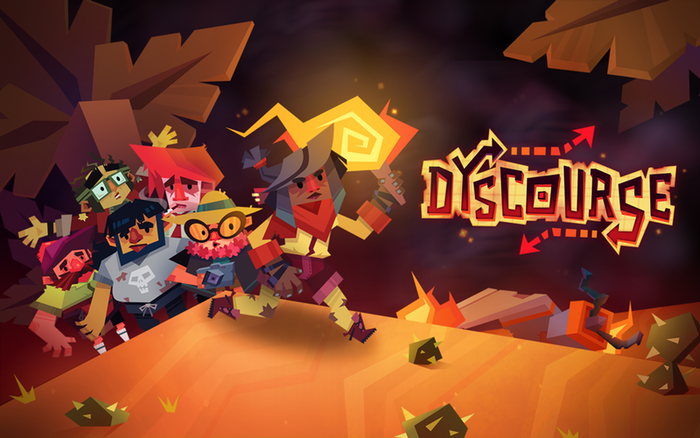
Why and how did you choose Kickstarter over other crowdfunding options available?
Kickstarter was the biggest and most well known.
How big was your budget before you launched your crowdfunding campaign?
We had already been working on the game for 7 months before the Kickstarter. The whole project took about 2 years to complete with a team that scaled from 4-10 people. The funds raised via the Kickstarter were just a part of the funding of Dyscourse.
How far along was your project before you felt ready to launch a crowdfunding campaign? In hindsight, would you have preferred to be farther along, or to have crowdfunded earlier?
We were 7 months into development prior to the Kickstarter. With this project, this was just enough time to figure out roughly what we wanted to build and be able to present that. Once you have crowdfunded something it becomes hard to drastically pivot your plan as that is not what people backed. Pivoting is a big part of game development. We ended up changing quite a bit from the original Kickstarter pitch, but the changes were not incredibly drastic and our backers were very supportive.
Can you explain how you prepared for and managed your campaign?
A lot of time and effort went into creating a great Kickstarter page. Graphics, videos and text. We had to figure out how to do physical rewards fulfilment (so we didn't undercharge). We also had a person to specially help with running the Kickstarter itself. Then there was all the work talking to the press and getting people excited for the Kickstarter. There is so much more that what is being described, it is a massive undertaking to launch and run a successful Kickstarter.
What tools did you use to market your campaign? Do you feel like you did so successfully, and if not, what could you have done differently?
Social media was a big part of getting the word out for our campaign. We were successful enough to get funded, which is the goal of crowdfunding at the end of the day. For marketing our Kickstarter I don’t know if there was anything I would have wanted to do differently.
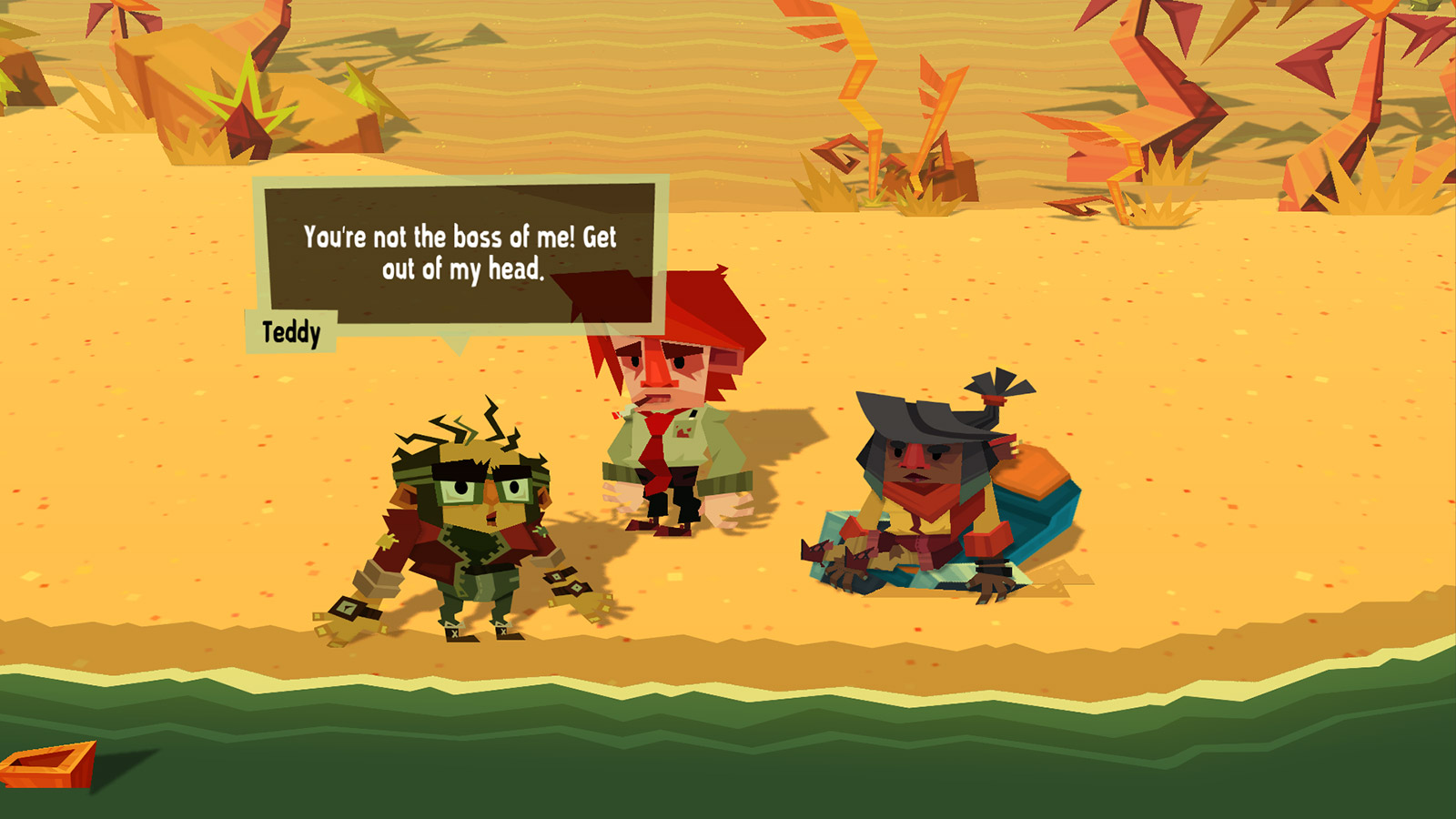
In retrospect what were your best assets for running this successful campaign? On the other hand, what would you do differently ?
There are a lot of fans of Owlchemy Labs so that helped a lot when running a Kickstarter. I can’t think of anything specific that should have been done differently. I only wish we would have known how much work it was going to be.
What was your biggest challenge during your campaign?
There are generally 3 kinds of Kickstarters. Ones that are rockets and are funded in less than 48 hrs, ones that no one is really interested in that fail almost immediately, and lastly there are the ones that go down to the wire. That was our Kickstarter. We got great support but it was both a marathon and a sprint. We got successfully funded but with not a lot of time to spare. This meant that for 30 days the whole team was working hard to make sure it would be successful. Which was not only very stressful but very time consuming. We also launched our Kickstarter on Nov 6, 2013, so this was leading right into the holiday season where generally people spent less money on crowdfunding. Also, this was at the same time as the PS4 and Xbox One console launches. That sucked a lot of money out of the Kickstarter ecosystem so it made getting funding that much more challenging.
What’s the most valuable advice you could share with aspiring crowdfunders?
It was super time consuming and stressful to run a Kickstarter campaign. It is one of the hardest and most stressful things I have ever done. If you are planning on crowdfunding talk to as many people that have been through the process as possible, before you decide if crowdfunding is right for you.
Dyscourse is now available on Steam (Win/Mac/Linux).
This post is part of the #CrowdfundingCrashCourse series. You can find the entire series of interviews and summary posts here.
Crowdfunding Crash Course: Kelly Tindall - Strangebeard
- by Alyson Shane
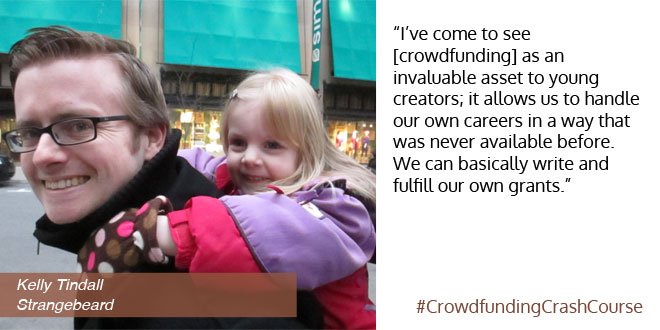
Kelly Tindall is an illustrator, cartoonist and a teacher. He writes the webcomic Strangebeard and used a Kickstarter campaign to raise the funds to print and distribute a finished book version of the comic.
Can you briefly describe Strangebeard?
Strangebeard is the two-fisted story of Jenny Brigham, servant girl, who is possessed by the ghost of the long-dead Pirate Emperor Augustus Strangebeard. Soon she finds herself with all his magical powers… but also the loyalty of his duplicitous pirate crew!
Why did you feel that the crowdfunding model was the best way to promote the comic?
It was the best option for me. I spent a year pitching it to comic-book publishers; almost all of them liked the book but nobody was willing to take a chance on an all-ages book starring a little girl. So, it fell to me to raise the money myself.
Why and how did you choose Kickstarter over other crowdfunding options available?
I was not an early adopter of Kickstarter; it felt desperate to me, initially. But I’ve come to see it as an invaluable asset to young creators; it allows us to handle our own careers in a way that was never available before. We can basically write and fulfill our own grants.
I chose Kickstarter because it’s got more credibility, and the rule about only receiving the funding if you make your budget makes it more like a game show; people love to back a winner.
How big was your budget before you launched your crowdfunding campaign?
$4500 CAD. I’m glad we went well over that, as the U.S. dollar started to strengthen and the final printing tally was a little over $5000. We ended up at about $8300 CAD at the end; every dime went to the project, and then some.
How far along was your project before you felt ready to launch a crowdfunding campaign? In hindsight, would you have preferred to be farther along, or to have crowdfunded earlier?
Nope, I picked a nearly perfect time. The book was nearly complete and all I had to do was compile existing work and secure the art for the pinup section. It might have been nice to be completely done but there’s always more you can do. At some point you just have to pull the trigger.
Can you explain how you prepared for and managed your campaign?
Tons of research. I had to figure out the printing costs, costs of extras for stretch goals, weight of shipped items, the costs for shipping materials, the costs to ship both to Canada and outside, how to put together a good video, and I had to create all the buttons and art for the Kickstarter itself. Probably a solid month’s part-time work.
What tools did you use to market your campaign? Do you feel like you did so successfully, and if not, what could you have done differently?
I think I did pretty well… I updated Twitter three times a day and Facebook every couple of days, and I appeared on at least six podcasts, a number of online interviews, one radio broadcast, and got featured in my hometown newspaper.
In retrospect what were your best assets for running this successful campaign? On the other hand, what would you do differently ?
I have very loyal family and friends who really stepped up to help out with money and were willing to talk to others about the campaign. To say nothing, of course, of the brilliant artists who supplied pinups for the book. I had over a year’s worth of loyal fans who couldn’t wait to read a print version of the story, too.
What was your biggest challenge during your campaign?
Ultimately, I think shipping and budgeting were the two that were the most difficult to deal with. I had a few odd-shaped items that needed to go (original art from the comic series) and they were a struggle to get out the door. Not having tiered options for shipping meant that overseas customers had to be charged above and beyond via messages, because their packages were so much more expensive and Kickstarter didn’t have shipping options for multiple countries.
What’s the most valuable advice you could share with aspiring crowdfunders?
Do your research. Talk to friends who have done Kickstarters and pick their brains. Don’t be afraid to market yourself, but don’t hassle people (especially strangers). Work hard, and get as much done as you can before the campaign ends. And have fun! People can tell when you’re enjoying yourself.
This post is part of the #CrowdfundingCrashCourse series. You can find the entire series of interviews and summary posts here.
Crowdfunding Crash Course: Meghan Athavale of POMO Inc - Lumo Play
- by Alyson Shane
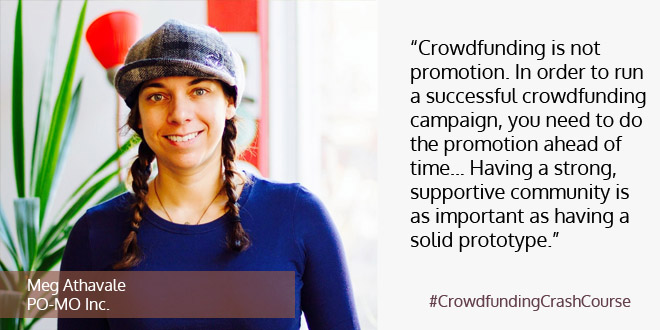
Meghan Athavale is an entrepreneur and artist. She is the co-founder and CEO of Po-Motion (PoMo) Inc and Lumo Play.
She is currently running an Indiegogo campaign to crowdfund the LUMO Interactive Projector.
Can you briefly describe Lumo?
Lumo is a turnkey gaming and display system that includes a projector, a sensor that captures motion data, and an Android processor. It projects games you would normally play on a touchscreen onto the floor of a child’s playroom, so they can play by jumping, moving, waving their arms and running. It also works as a regular projector, so you can play movies with it, and non-motion reactive games (using a bluetooth controller.) Finally, Lumo has an online content creation suite designed so that young children can customize games using their own artwork.
Why did you feel that the crowdfunding model was the best way to promote Lumo?
We’ve been seeking investment for Lumo for about a year. It’s tough to get investment for hardware, and even tougher if your company is based in a place with very little access to VC communities. VCs only fund about 1% of the deals they see. Here’s a great article explaining why: http://www.startupcfo.ca/2012/08/top-10-signs-your-business-is-not-vc-fundable/
Lumo doesn’t have traction yet, because it isn’t for sale yet. It’s not for sale because we need funding to produce it. We know people want it, but we don’t know how many people want it yet. Crowdfunding, in our case, is a great way to allow our market to tell us what they want in terms of features and price point, without the risk of spending hundreds of thousands of dollars producing a bunch of Lumos first.
Having said that, crowdfunding is not promotion. In order to run a successful crowdfunding campaign, you need to do the promotion ahead of time. We learned that when our first attempt on Kickstarter failed epically.
Why and how did you choose Indiegogo over other crowdfunding options available?
We did Kickstarter in September 2013 with a very very early stage prototype and no marketing. It still raised around $25,000, but it wasn’t enough to move the project forward, so we regrouped and joined a 4 month incubator, visited China, and hired some engineers.
We’re now launching on Indiegogo for two reasons. 1) they have a partnership with the hardware incubator we attended, so we got a lot of support regarding pre-campaign prep and marketing for our upcoming launch (we couldn’t even get a contact email from Kickstarter) and 2) The flexible funding option makes sense for us right now. We can make 10 Lumos or we can make 10,000 Lumos, depending on market demand. We don’t have to meet our goal to move forward. That wasn’t the case in 2013.
How big was your budget before you launched your crowdfunding campaign?
The first campaign had no budget. In total we’ve spent around $5000 in marketing activities this time. This includes attending SXSW, running facebook ads, and running a contest using a tool called Gleam.
How far along was your project before you felt ready to launch a crowdfunding campaign? In hindsight, would you have preferred to be farther along, or to have crowdfunded earlier?
The first campaign, on Kickstarter, wasn’t nearly far enough along. In retrospect I would have waited until we had a prototype that was only a few steps from DFM (design for manufacturing). We have that now.
More importantly, though, I wish I’d spent a year reaching out to people and building a community before launch. Having a strong, supportive community is as important as having a solid prototype.
Can you explain how you prepared for and managed your campaign?
The first campaign was a one-person show. I had some help making a few games and shooting the video, but overall the whole thing was my personal learning experience. This time we have a delegation process. Someone is in charge of the video. Someone else is in charge of design. I am in charge of PR and marketing, and the developers can focus on making the thing work.
What tools did you use to market your campaign?
I only used social media and local news coverage on my last launch. We managed to get a big spread story in the Globe and Mail that went out a week before our campaign went live.
This year I used Gleam, Thunderclap, fb ads, and attended a pile of events and conferences. I also believe in old-school hustle, so I invite parents and families in the Los Angeles area to come hang out with me and play with Lumo. The best way to build supporters is to actually show them your product and meet them in person, I find.
What was your biggest challenge during your campaign? What could you have done differently?
The biggest challenge with the Kickstarter was exposure. We also didn’t really know what our marketing message was at that point.
I think the biggest challenge on the upcoming campaign will be keeping up with correspondence. We are already getting tons of calls and emails, and there’s really only two people on hand to answer them.
We have a list of over 30 people on standby to help us if we need them.
In retrospect what were your best assets for running your original campaign? Since you’re launching another campaign soon, how do you plan to apply these lessons this time?
The best thing we did with our original campaign was saving the email list and keeping up with the original community. They are our biggest advocates, since they know how far we’ve come.
What’s the most valuable advice you could share with aspiring crowdfunders?
Keep a very open mind, spend as much time as possible building an email list, and don’t be afraid to ask for help. You are about to ask hundreds of strangers for their money. You should get used to defending yourself in the nicest possible way, which means you will have to talk to hundreds of people before you launch to get your messaging and language right.
If your campaign isn’t going well, shut it down and try again later. If you let it run it’s course and fail, you will have a dead skeleton of a kickstarter haunting the interwebz for all eternity (like we do). It’s totally okay to shut down early, regroup, and try again. Your community will understand. They want you to succeed.
This post is part of the #CrowdfundingCrashCourse series. You can find the entire series of interviews and summary posts here.
Crowdfunding Crash Course: Adam Brooks of Astron-6 - The Editor
- by Alyson Shane
Adam Brooks is an actor, writer and founding member of Astron-6, a Winnipeg-based film production company. They used Indiegogo to crowdfund their film The Editor.
Can you briefly describe The Editor?
Yep. It’s an absurdist giallo movie about a film editor suspected of murdering a number of his co-workers in a film studio in the late 1970s.
Why did you feel that the crowdfunding model was the best way to promote the film?
Because it required the least investment for the highest gain - nothing to lose.
Why and how did you choose Indiegogo over other crowdfunding options available?
I didn’t spend much time researching it but they seemed to keep a smaller chunk for themselves than their competition.
How big was your budget before you launched your crowdfunding campaign?
$120k.
How far along was your project before you felt ready to launch a crowdfunding campaign? In hindsight, would you have preferred to be farther along, or to have crowdfunded earlier?
It’s a bit of a long and boring story - we had started to shoot ‘The Editor’ as a fake trailer on SLR and eventually decided we might as well try to make an actual feature out of it. We wrote a script and applied for telefilm’s microbudget program.
Can you explain how you prepared for and managed your campaign?
We brainstormed a list of rewards minutes before taping the pitch video and then uploaded it to indiegogo and posted it all over our social media.
What tools did you use to market your campaign? Do you feel like you did so successfully, and if not, what could you have done differently?
We've built a small audience already, so all the blogs that had previously taken an interest in our material were happy to post the indiegogo without us asking.
I think it was successful - we exceeded our goal.
In retrospect what were your best assets for running this successful campaign? On the other hand, what would you do differently?
I think you need a cool project, and cool rewards…. I really wish I’d budgeted all the postage I’ve had to spend on the rewards though or budgeted to pay somebody to do it for me.
What was your biggest challenge during your campaign?
I don’t know. We already had $120k. Our campaign was just trying to get us an additional $16k to punch up what we already had. A year after the campaign it turned out we really needed that money just to finish the thing, but we kept our end of the pitch’s promise and packed the movie with violence, sex, stunts and names.
What’s the most valuable advice you could share with aspiring crowdfunders?
Make a comic with the Soskas.
This post is part of the #CrowdfundingCrashCourse series. You can find the entire series of interviews and summary posts here.
Introducing: the Crowdfunding Crash Course!
- by Alyson Shane
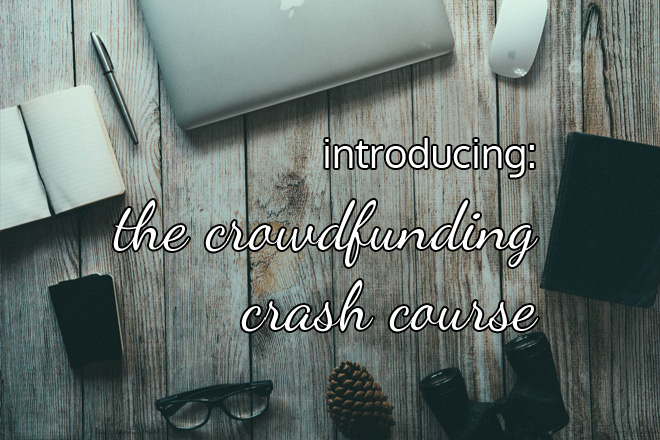
The other weekend John and I finally sat down and watched Indie Game: The Movie. This amazing piece of cinema is from Canadian filmmakers James Swirsky and Lisanne Pajot. It follows indie video game developers as they struggle to develop and release Super Meat Boy and Fez, respectively, as well as interviews with Jonathan Blow, the developer behind Braid.
James and Lisanne ran two successful crowdfunding campaigns to fund the film, and after the movie I got to wondering: what makes a crowdfunding campaign successful?
Having never run a crowdfunding campaign myself, I figured that the best way to gain a deeper understanding of this booming phenomenon was to seek out knowledge from those around me.
With that in mind, I'm launching the #CrowdfundingCrashCourse project, where I'll be interviewing startups, musicians, businesspeople, and anyone else I can find who can share their experiences about running a crowdfunding campaign.
The first post, which will go up this week, is with Adam Brooks of Winnipeg-based film production company Astron-6, who used Indiegogo to crowdfund their movie The Editor.
I'm really excited to be starting this project and to share it with you and am always looking for new participants to share their knowledge. If you've run a crowdfunding campaign, or know someone who has and should be featured as a part of this project, please feel free to give me a shout.
This post is part of the #CrowdfundingCrashCourse series. You can find the entire series of interviews and summary posts here.
